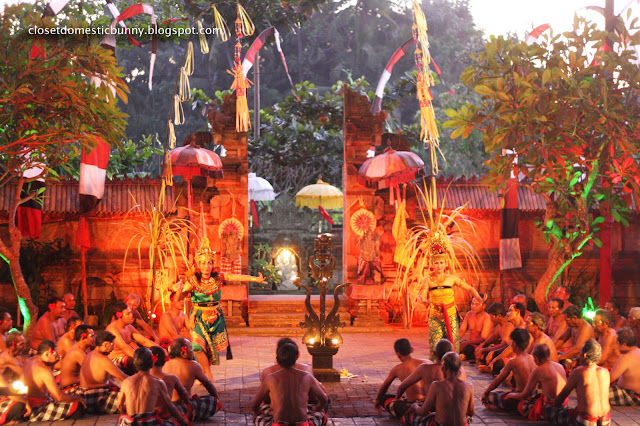We went straight to Jambe Budaya from Tanah Lot and arrived an hour before the performance was due to start. This was really early in any standard, but even more so in Indonesian standard.
Jambe Budaya is one of the smaller, lesser known places in Bali where Kecak is performed nightly.
Jambe Budaya is one of the smaller, lesser known places in Bali where Kecak is performed nightly.
We walked around the place, took a photo of the decked out stage.
Of the statues basked in the light of the slowly descending sun.
We watched the kerosene lights being lit up by the smiling stagehand.
We even talked to this beautiful lady. She was a member of the welcoming party. She’d give you a fragrant smelling frangipani to tuck behind your ear and oblige you with a picture.
Getting closer to curtain time, we heard some deafening gamelan playing at the entrance. So we backed out of the stage in search of the source of the sound.
Here was a troupe of gentlemen playing the gamelan. Man boobs, tee hee hee….
Gamelan music is not my favourite type of music, it’s very loud and brassy. This is true of a lot of traditional Indonesian instruments.
That is probably why I like Kecak.
Kecak is not accompanied by any music, but in its place is the continuous chants of the word “Cak cak cak” over and over again by a chorus of 50 performers or so, providing a sort of entrancing beat that sets the pace of the performance.
It is one of those eternal good vs evil story.
The protagonists are Rama, a prince and heir to a kingdom; and Sita, his beautiful wife.
Now if you thought Rama’s features are particularly feminine in this picture, you would be right. Because this Rama was actually played by a woman.
The antagonist is Ravana, the king of demons, who lusts over the beautiful Sita. So, he kidnap her and hid her in his palace, naturally.
The ensuing story is how Rama, his brother, a bird, and an army of monkeys attempted to rescue Sita.
The antagonist is Ravana, the king of demons, who lusts over the beautiful Sita. So, he kidnap her and hid her in his palace, naturally.
The ensuing story is how Rama, his brother, a bird, and an army of monkeys attempted to rescue Sita.
This character here is Garuda, a giant bird, who came to save Rama by pecking a snake that tried to kill Rama.
Kecak is based on the old hindu story of ramayana. If you're interested in reading more about it, wikipedia has a good summary of the plot. My version of the story may differ slightly from wikipedia, as mine is taken from the summary handed out in Jambe Budaya.
The whole performance was closed by a scene of an entranced man, dancing around a bonfire out of coconut husks, while dressed like a horse.
This particular dance is called sanghyang jaran.
Sanghyang is based on the idea that a spirit enters the performer's body, making them impervious to pain.
Jaran means horse.
At one point the fire seemed to completely envelope the performer.
But then, he came out visibly unharmed.
All of the performers in their beautiful costumes.
Jambe Budaya
Jalan Pasekan, Batu Bulan
Gianyar BALI
Performances 7 days 6.30pm-7.30pm
The whole performance was closed by a scene of an entranced man, dancing around a bonfire out of coconut husks, while dressed like a horse.
This particular dance is called sanghyang jaran.
Sanghyang is based on the idea that a spirit enters the performer's body, making them impervious to pain.
Jaran means horse.
At one point the fire seemed to completely envelope the performer.
But then, he came out visibly unharmed.
All of the performers in their beautiful costumes.
Jambe Budaya
Jalan Pasekan, Batu Bulan
Gianyar BALI
Performances 7 days 6.30pm-7.30pm













No comments:
Post a Comment
Thank you for reading. I appreciate your constructive feedback and will answer any questions you might have. Comments that are rude, abusive, written with the intent to advertise, contain profanity or considered spam will not be published.